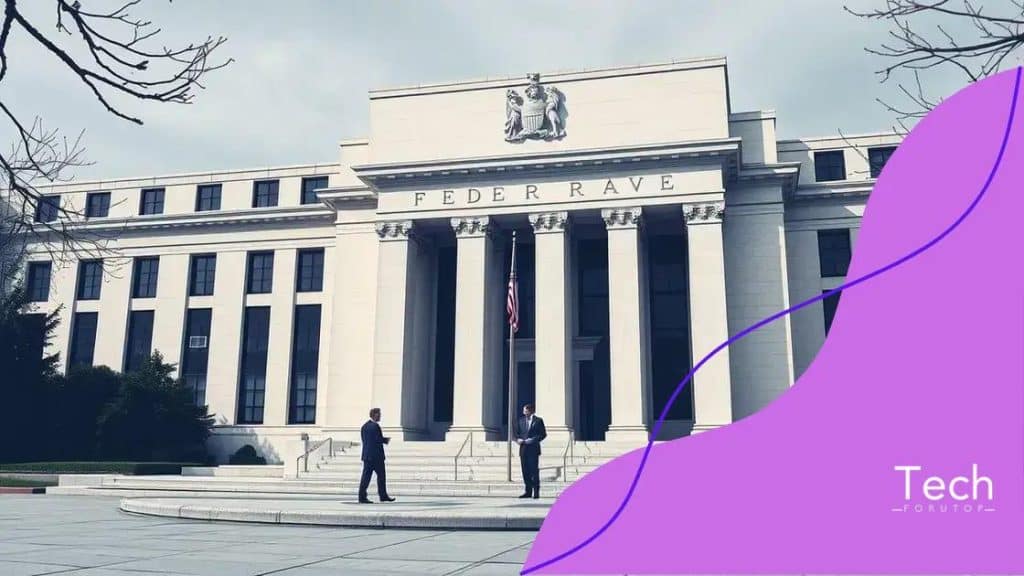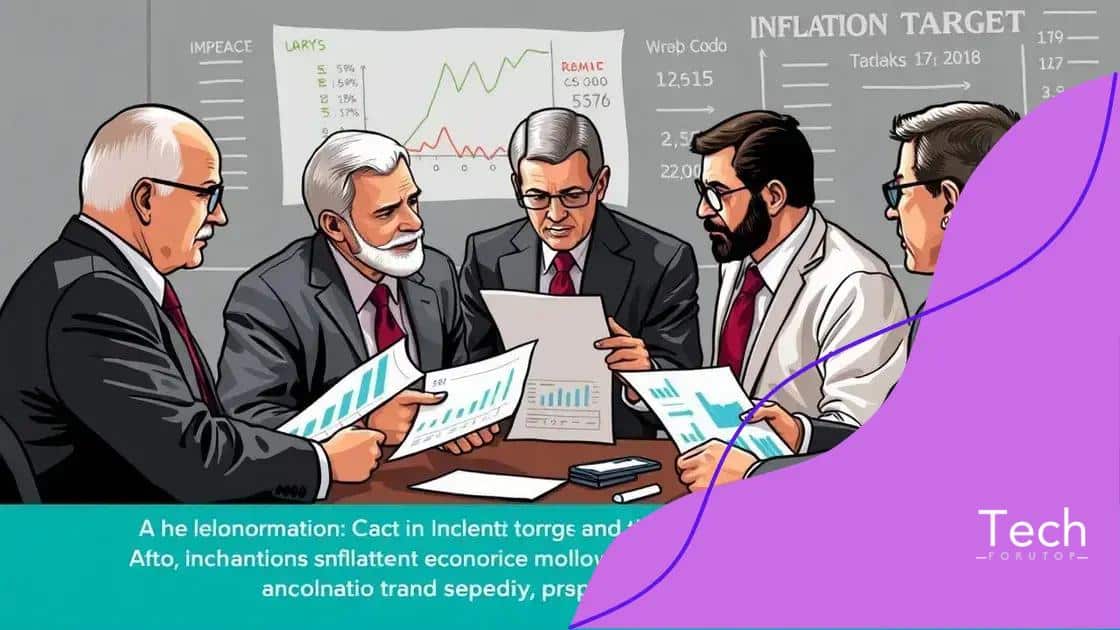Fed inflation target revision debate: what’s at stake?

The Fed inflation target revision debate centers on how changes in the inflation target can affect interest rates, consumer prices, and global economic conditions, impacting both domestic and international markets.
The Fed inflation target revision debate is heating up, raising questions about future economic stability. What happens if the target shifts? Let’s dive into this complex issue.
Understanding the current Fed inflation target
The current Fed inflation target plays a vital role in shaping economic policy. Understanding this target helps us gauge how the Federal Reserve influences inflation.
What is the current inflation target?
The Federal Reserve has set its inflation target at around 2%. This target aims to promote stable prices and support economic growth. A stable inflation rate helps consumers and businesses plan for the future.
Why is the target set at 2%?
Aiming for 2% allows for a balance between economic growth and price stability. It is also low enough to prevent deflation, which can be harmful to the economy. Keeping inflation around this level helps maintain consumer confidence.
- Avoids significant price fluctuations
- Encourages investment by ensuring stable prices
- Supports wage growth
- Helps smooth out economic cycles
When inflation is controlled at a target of 2%, households and businesses can predict costs more accurately. This predictability helps them make informed spending and investment decisions. If the inflation rate drifts too far from this target, it can lead to either rising costs or economic stagnation.
Adjustments to this target can provoke significant debates among economists and policymakers. They often discuss whether the 2% target still meets the needs of an evolving economy. Recent discussions have considered the impacts of global changes and emerging technologies on inflation.
As we analyze the current Fed inflation target, it becomes clear that this figure is not just a number, but a reflection of broader economic goals. It influences interest rates, employment, and fiscal policies. By understanding how this target works, we also gain insights into economic trends and potential shifts in policy.
Historical context of inflation targets
The historical context of inflation targets provides valuable insights into how economic policies have evolved. Understanding this context is crucial for grasping the current debates.
Origins of inflation targeting
Inflation targeting started gaining traction in the early 1990s. Central banks, particularly in New Zealand, began using this approach to combat inflation. The idea was simple: set a specific inflation rate and communicate it clearly to the public.
Key milestones
- In the 1980s, high inflation rates prompted the need for better controls.
- The Bank of England officially adopted inflation targeting in 1992.
- The idea spread globally, with many countries following suit, enhancing transparency.
- By the late 1990s, several major economies had embraced this framework.
As time progressed, inflation targets became a tool to enhance economic stability. By setting clear targets, central banks aimed to build trust with the public. The expectation was that by keeping inflation under control, economic growth would follow smoothly.
Over the years, challenges have arisen, such as sudden economic shocks or changes in global dynamics. These factors sometimes make it difficult for central banks to adhere to their targets. Policymakers have since had to reconsider the flexibility of the targets, especially in light of recent events like financial crises.
The acceptance of historical inflation targets has led to discussions about how relevant these targets are today. Factors like globalization and technology have altered the economic landscape, prompting a reevaluation of how effective these historical targets will be in the future.
Impacts of potential revisions on the economy

The impacts of potential revisions to the Fed’s inflation target can be significant. Changes in this target may influence various aspects of the economy.
Effects on interest rates
One major impact is on interest rates. If the Fed revises its target upward, it may lead to increased interest rates. This is done to combat rising inflation. Higher interest rates can discourage borrowing, potentially slowing down economic growth.
Consumer behavior
Changes in inflation targets can also alter consumer behavior. If consumers expect higher inflation, they might spend more now rather than later. This could increase current demand, impacting prices in the short term.
- Immediate rise in consumer spending
- Changes in savings patterns
- Potential impact on housing and big-ticket purchases
- Increased uncertainty about future prices
Additionally, businesses may respond differently based on the revisions. Companies might adjust their pricing strategies, leading to shifts in the market landscape. If businesses anticipate higher inflation, they may increase prices proactively. This could create a ripple effect across various industries.
Moreover, potential revisions can spark debates among policymakers and economists. Some argue that flexibility in inflation targets allows for better responses to economic shocks. Others worry that it may lead to a loss of credibility for the Federal Reserve.
Overall, the impacts of potential revisions are complex. They involve various stakeholders, including consumers, businesses, and policymakers. The overarching concern is maintaining economic stability while navigating these changes.
Debating the consequences for consumers
The debate about the consequences for consumers regarding inflation target revisions is critical. As policies shift, consumers feel the effects in their daily lives.
Rise in prices
One major concern among consumers is the potential rise in prices. If the Federal Reserve adjusts its inflation target upwards, consumers may face higher costs for goods and services. Increased prices can shrink household budgets, making it harder for families to meet their needs.
Impact on purchasing power
Another consequence relates to purchasing power. When inflation rises, the value of money decreases. This situation means that consumers can buy less with the same amount of money. For example, if wages do not keep pace with inflation, many consumers will struggle to maintain their standard of living.
- Increased costs for necessities like food and fuel
- Challenges in saving for future goals
- Higher interest rates on loans
- Potential loss of financial stability
Additionally, the debate highlights the psychological effects of inflation. If consumers fear that prices will continue to rise, they may change their spending behavior. This could lead to increased demand for certain products as people rush to buy before prices escalate further.
Conversely, some argue that a well-communicated inflation target can actually help consumers. Clear guidance from the Federal Reserve may boost confidence in the economy. If consumers understand inflation dynamics, they might be more willing to spend, which can stimulate growth.
Ultimately, the consequences for consumers in light of inflation target revisions depend on many factors. The balance between effective communication and economic realities will shape how these changes affect everyday life.
Global reactions to the Fed’s inflation policy
The global reactions to the Fed’s inflation policy showcase how interconnected the world economy has become. When the Federal Reserve changes its inflation targets or policies, countries around the globe respond in various ways.
Currency fluctuations
One immediate effect is often seen in currency markets. When the Fed signals a shift in its inflation stance, it can lead to significant changes in the value of the US dollar. For instance, if the Fed raises interest rates to combat inflation, the dollar may strengthen. A stronger dollar makes imports cheaper but can hurt US exports.
International trade impacts
Changes in the Fed’s policy can also affect international trade. Countries depend on stable economic policies, so fluctuations can lead to uncertainty. This uncertainty may cause nations to adjust their trade agreements and strategies, impacting supply chains worldwide.
- Potential for increased tariffs on imports
- Shifts in export demand
- Changes in foreign investment patterns
- Economic strain on emerging markets
Countries with close economic ties to the United States often feel these effects the most. Nations such as Canada and Mexico might experience immediate reactions in their markets and currencies. However, even countries farther away can be impacted indirectly.
Moreover, central banks around the world pay close attention to the Fed’s policies. If the Fed adopts a more aggressive inflation strategy, other central banks might follow suit to maintain balance. These collective moves can lead to a synchronized response in global interest rates.
Overall, the global reactions reflect how crucial the Fed’s inflation policy is to the stability of economies worldwide. The ripple effects of these decisions can alter economic forecasts and investment strategies all around the globe.
FAQ – Frequently Asked Questions about Fed Inflation Target Revisions
What is the current inflation target set by the Fed?
The current inflation target set by the Federal Reserve is around 2%, aimed at promoting stable prices and economic growth.
How do inflation target revisions impact consumers?
Revisions can lead to changes in interest rates and prices, affecting consumer purchasing power and spending habits.
What global effects can Fed policy changes have?
Changes in the Fed’s inflation policy can lead to currency fluctuations and impacts on international trade, affecting economies worldwide.
Why is it important for businesses to monitor inflation targets?
Monitoring inflation targets helps businesses anticipate changes in the economic environment, allowing them to adjust strategies for pricing and investment.





